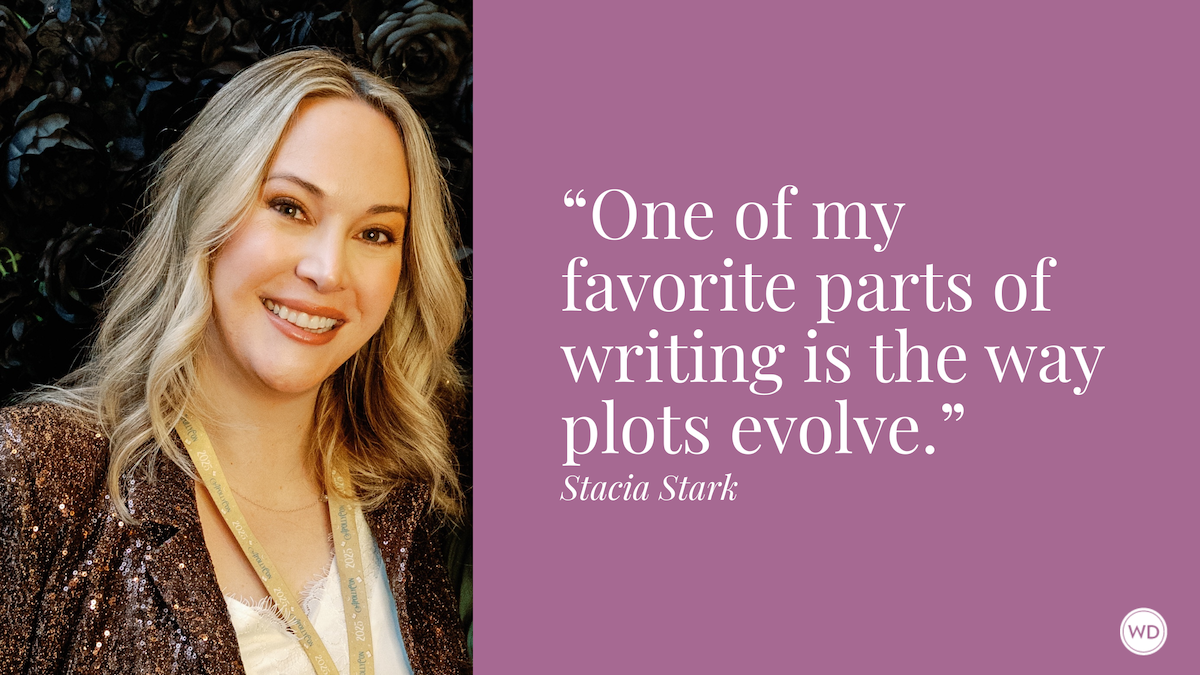7 Steps to Creating a Flexible Outline for Any Story
Many writers who swear they dislike outlines are thinking of them in the wrong ways. K.M. Weiland’s seven-step process to creating a flexible outline for any story can help you let loose and have fun in your first draft.
Mention the word outline in a room full of writers, and you’re sure to ignite a firestorm of passionate debate. Writers either love outlines, or they hate them. We either find them liberating, or we can’t stand how confining they are.
My experience has been that more often than not, those who swear they dislike outlines are thinking of them in the wrong ways. Outlines are not meant to trap you into preset ideas or sap your creativity before you start the first draft. Outlines are also definitely not meant to be lifeless Roman-numeral lists.
To imbue your writing with the full power of outlining, you need to approach the process from a mindset of flexibility and discovery. When you do this, you’ll end up with a road map to storytelling success. Road maps are there to show you the fastest and surest way to reach your destination, but they certainly don’t prevent you from finding exciting off-road adventures and scenic drives along the way.
At their best, outlines can help you flesh out your most promising story ideas, avoid dead-end plot twists and pursue proper structure. And the greatest part? They save you time and prevent frustration. Sketching out your plot and characters in your first draft can take months of trial and error. Figuring out those same elements in an outline requires a fraction of the time—and then allows you to let loose and have fun in your first draft.
Let’s take a look at how to get the most out of the outlining process, beginning with the shaping of your premise and working all the way through to a complete list of scenes. (Note: Although this outlining method is one I use myself and highly recommend, keep in mind that there is no right or wrong way to outline a story. The only requirement is that you find the groove that works for you. If you start outlining and begin to feel the technique isn’t working for you, rather than denouncing outlines entirely, consider how you might adjust the process to better suit your personality and creative style.)
1. Craft your premise
Your premise is the basic idea for your story. But it’s not enough to just have an idea. “Guy saves girl in an intergalactic setting” is a premise, but it’s also far too vague to offer much solid story guidance.
This is why your outline needs to begin with a tightly crafted premise sentence that can answer the following questions:
- Who is the protagonist?
- What is the situation? What is the hero’s personal condition at the beginning? How will that condition be changed, for better or worse, by the hero himself or by the antagonistic force?
- What is the protagonist’s objective? At the beginning, what does the hero want? What moral (or immoral) choices will she have to make in her attempt to gain that objective?
- Who is the opponent? Who or what stands in the way of the hero achieving his objective?
- What will be the disaster? What misfortune will befall the hero as the result of her attempts to achieve her objective?
- What’s the conflict? What conflict will result from the hero’s reaction to the disaster? And what is the logical flow of cause and effect that will allow this conflict to continue throughout the story?
Once you’ve answered these questions, combine them into one or two sentences:
Restless farm boy (situation) Luke Skywalker (protagonist) wants nothing more than to leave home and become a starfighter pilot, so he can live up to his mysterious father (objective). But when his aunt and uncle are murdered (disaster) after purchasing renegade droids, Luke must free the droids’ beautiful owner and discover a way to stop (conflict) the evil Empire (opponent) and its apocalyptic Death Star.
2. Roughly sketch scene ideas
Armed with a solid premise, you can now begin sketching your ideas for this story. Write a list of everything you already know about your story. You’ll probably come to this step with a handful of scenes already in mind. Even if you have no idea how these scenes will play out in the story, go ahead and add them to the list. At this point, your primary goal is to remember and record every idea you’ve had in relation to this story.
Once you’ve finished, take a moment to review your list. Whenever you encounter an idea that raises questions, highlight it. If you don’t know why your character is fighting a duel in one scene, highlight it. If you don’t know how two scenes will connect, highlight them. If you can’t picture the setting for one of the scenes, highlight that, too. By pausing to identify possible plot holes now, you’ll be able to save yourself a ton of rewriting later on.
Your next step is to address each of the highlighted portions, one by one. Write out your ideas and let your thoughts flow without censoring yourself. Because this is the most unstructured step of your outline, this will be your best opportunity to unleash your creativity and plumb the depths of your story’s potential. Ask yourself questions on the page. Talk to yourself without worrying about punctuation or spelling.
Every time you think you’ve come up with a good idea, take a moment to ask yourself, “Will the reader expect this?” If the answer is yes, write a list of alternatives your readers won’t expect.
3. Interview your characters
In order to craft a cast of characters that can help your plot reach its utmost potential, you’ll need to discover crucial details about them, not necessarily at the beginning of their lives but at the beginning of the story.
To do this for your protagonist, work backward from the moment in which he will become engaged in your plot (the “disaster” in your premise sentence). What events in your protagonist’s life have led him to this moment? Did something in his past cause the disaster? What events have shaped him to make him respond to the disaster in the way he does? What unresolved issues from his past can further complicate the plot’s spiral of events?
Once you have a basic idea of how your character will be invested in the main story, you can start unearthing the nitty-gritty details of his life with a character interview. You may choose to follow a preset list of questions (you can find a list of more than 100 such questions in my book Outlining Your Novel: Map Your Way to Success), or you may have better luck with a “freehand interview” in which you ask your protagonist a series of questions and allow him to answer in his own words.
4. Explore your settings
Whether your setting is your childhood neighborhood or the seventh moon of Barsoom, you’ll want to enter your first draft with a firm idea of where your prominent scenes will be taking place.
Don’t choose a setting just because it sounds cool or because you’re familiar with it. Look for settings that will be inherent to your plot. Can you change your story’s primary locale without any significant alterations to the plot? If so, dig a little deeper to find a setting better suited to your plot, theme and characters.
Based on the scenes you’re already aware of, list the settings you think you’ll need. Can you reduce this list by combining or eliminating settings? Nothing wrong with a sprawling story locale, but extraneous settings should be eliminated just as assiduously as unnecessary characters.
5. Write your complete outline
You’re finally ready to outline your story in full. This is where you will begin plotting in earnest. In Step 2, you solidified the big picture of your story by identifying the scenes you were already aware of and figuring out how they might fit together. Now, you will work through your story linearly, scene by scene, numbering each one as you go. Unlike the “sketches” in Step 2, in which your primary focus was on brainstorming and exploring possibilities, you will now be concentrating on molding your existing ideas into a solid structure.
How comprehensive you want to be is up to you. You may choose to write a single sentence for each scene (“Dana meets Joe at the café to discuss their impending nuptials”), or you may choose to flesh out more details (“Joe is sitting by himself in a booth when Dana arrives; Dana orders coffee and a muffin; they fight about the invitation list”). Either way, focus on identifying and strengthening the key components of each scene’s structure. Who will be your narrating character? What is his goal? What obstacle will arise to obstruct that goal and create conflict? What will be the outcome, and how will your character react to the resulting dilemma? What decision will he reach that will fuel the next scene’s goal?
Work to create a linear, well-structured plot with no gaps in the story. If you can get this foundation right in your outline, you’ll later be free to apply all your focus and imagination to the first draft and bring your story to life.
As you mentally work through each scene, watch for possible lapses of logic or blank areas in how one event builds to another. Take the time to think through these potential problems so they won’t trip you up later. If you get stuck, try jumping ahead to the next scene you know, and then working backward. For instance, if you know where you want your characters to end up, but not how they’ll get there, start at the ending point and then see if you can figure out what has to happen in the preceding events to make it plausible.
6. Condense your outline
Once you’ve finished your extended outline, you may want to condense the most pertinent points into an abbreviated version. Doing so allows you to weed out extraneous thoughts and summarize the entire outline into a scannable list for easier reference. Because your full outline may contain a fair amount of rambling and thinking out loud on the page, you’re likely to end up with a lot of notes to review (I often have nearly three notebooks of material). Rather than having to wade through the bulk of your notes every time you sit down to work on your first draft, you can save yourself time in the long run by doing a little organizing now.
You may choose to create your abbreviated outline in a Word document, write out your scenes on index cards, or use a software program such as the free Scrivener alternative yWriter.
7. Put your outline into action
By now, you’ll be feeling prepared and eager to get going on your first draft. Each time you sit down to work on your manuscript, begin by reviewing your outline. Read the notes for your current scene and the scene to follow. Before you start writing, work through any remaining potential problems in your head or on paper. If the time comes (and it will come) when you’re struck with a better idea than what you had planned in your outline, don’t hesitate to go off-road. These ventures into unknown territory can result in some of the most surprising and intriguing parts of your story.
An outline will offer you invaluable structure and guidance as you write your first draft, but never be afraid to explore new ideas as they occur. Remember, your outline is a map showing you the route to your destination, but that doesn’t mean it is the only route.
Enter your email below to receive a free download, "Plot Development: Charts and Tips for Outlining and Plotting a Novel."
In WD University's 12 Weeks to a First Draft, you will tackle the steps to writing a book, learn effective writing techniques along the way, and of course, begin writing your first draft. Register today!
K.M. Weiland. Weiland is the IPPY and NIEA Award-winning and internationally published author of the Amazon bestsellers Outlining Your Novel and Structuring Your Novel, as well as Jane Eyre: The Writer’s Digest Annotated Classic, the western A Man Called Outlaw, the medieval epic Behold the Dawn, the portal fantasy Dreamlander, and the historical/dieselpunk adventure Storming. When she’s not making things up, she’s busy mentoring other authors on her award-winning blog Helping Writers Become Authors. She makes her home in western Nebraska.









